Rules
RULES FOR SERIES PLAY
SERIES PLAY IS A BEST-OF-SEVEN COMPETITION BETWEEN TWO OPPONENTS, ONE ON EACH SIDE OF THE COURT.
TWO POINTS ARE AWARDED TO THE WINNER. THESE ARE CALLED "SERIES POINTS" AND CAN BE ARCHIVED ON OUR WEBSITE. A WIN BY A STICK SKUNK IS FOUR POINTS, AND A WIN BY A SUPER STICK SKUNK IS SIXTEEN PTS.
RULE NO. 1: Ball & Court
You must play with a junior-sized football. The word "junior" or the equivalent must be on the ball. The ball must be inflated properly but not overinflated, allowing for a slight squeeze when gripped. You must play on a standard tennis court, or on a grass or asphalt court that is lined with the correct dimensions and boxes of a standard tennis court. The lines for these courts can be no wider then four inches and no thinner than the size of the rope or tape used in the lining. For grass or asphalt courts, a rope stretched across the middle of the court and that is at a height between 3' and 3'6'' at all points can serve as an official net.
RULE NO. 2: The Touch-Net Rule
Players cannot touch the net while a game is live. A touch is any body part of any player touching any part of the net at any time. This includes touching the net in live play but also simply reaching out to touch the net in a non-play action as long as the game is still a live game and you are a participant on the court. The following scenarios are possible:
2a. You are offense and you touch the net before you kick, whether you are holding the ball or not. In this case, it is a transfer of ball and a free point to the defense, and play continues.
2b. You are offense and you touch the ball as you kick or after you kick, and the kick is still live (that is, it has not yet touched the court on the other side), then the defender can call for a null play and receive a free point and the ball or the defender can decline the penalty and accept the result of the play as if the net had never been touched. The latter option may be the desired one if the defender catches the ball and wins the game.
2c. If you are defense and you touch the net at any point, whether the offense is handling the ball or not (the ball may be still on the court), the offense is awarded one point and play continues.
The exception to this rule is a player touching the net to retrieve a dead ball that is at rest and has nestled in the net. This is permissible if the player says "Net" first to let others know they are touching the net in accordance with this rule.
RULE NO. 3: Start of Game, Delay of Game, & Score Calling
To begin a game, the opening punter says "Punters" and the defender says "Rule!" Both words must be audible to each player. It is also permissible to start the game by having the kicker signal a "P" with American Sign Language, and the defender to return signal an "R" in ASL. The loser of the previous game starts a new game with the ball. The loser of a series (best out of 7 games) starts a new series with the ball. If no games have been played that day, the younger player starts with the ball.
A player on offense has 15 seconds to kick the ball once the ball meets two conditions: it has been touched at least once by an offensive player while the ball has been inbounds at least once.
It is puntball etiquette for a player to call out the current score once a possession. The ball-handler's score always goes first in the call-out. For example, if a player has the ball and their score is 4 while the defense's score is 2, the call would be "4-2." If the offense kicks a fiver (a 5-point kick) and makes it without allowing the defense to score points, the defense would then pick up the ball and call out "2-9."
RULE NO. 4: Game Points
The puntball (tennis) court is divided into sections according to points assigned to the sections:
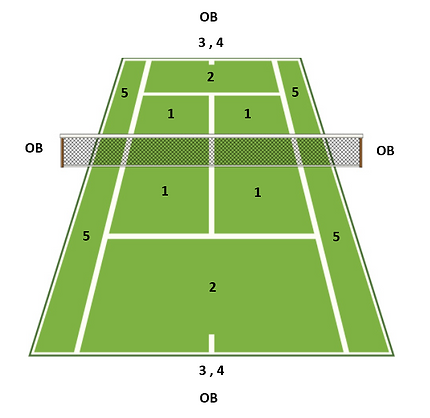
A punter's plant leg is the leg that is not kicking the ball, and the foot of the plant leg must be inside a section touching the court as the kick is made (except for the 3-pointer and the 4-pointer, which will be discussed below). The plant leg cannot be on a line or any part of a line. If the plant leg is touching a line when the kick is made, the kick is a dead kick, and the defender gets the ball.
A kick or punt is defined as having a drop (the ball must leave the hand and pass through the air before making contact with the foot) and a bounce (the ball must ricochet or rebound off the punter's foot). The kick must cross over the net without bouncing on the kicker's side first. If a ball goes into the net, this is known as a "net ball." A kicker is allowed one net ball per possession. If the balls goes into the net for a second time on the same possession, the defender gets the ball and a point. Kicks that skew to the side and fail to cross the top of the net but nevertheless land on the kicker's side (out of bounds) are considered net balls.
For the 1-pointer, 2-pointer, and 5-pointer ("fiver"), the punter makes the kick to the section on the defense side of the court that corresponds to the section the punter's plant leg is in. If the ball lands in that corresponding section, or anywhere on the line of the corresponding section, the kicker receives the points assigned to that section.
4a. A person's score can never be negative.
4b. For a kick originating in one of the two 1-point sections, the punter must aim at the 1-point section directly on the other side of the net, not diagonally on the other side.
4c. For a kick originating in a 2-point section, the punter must aim at the 2-point section on the other side of the net.
4d. For a kick originating in a 5-point section, the punter must stand somewhere on the second half of their 5-point section and aim at any point of the 5-point section directly on the other side of the net.
4e. Remember, the line is ALWAYS in, so if a ball part even just barely nicks the line that outlines the box the ball is being kicked to, the kick is good.
Here are examples of successful and unsuccessful 1-point, 2-point, and 5-point kicks:

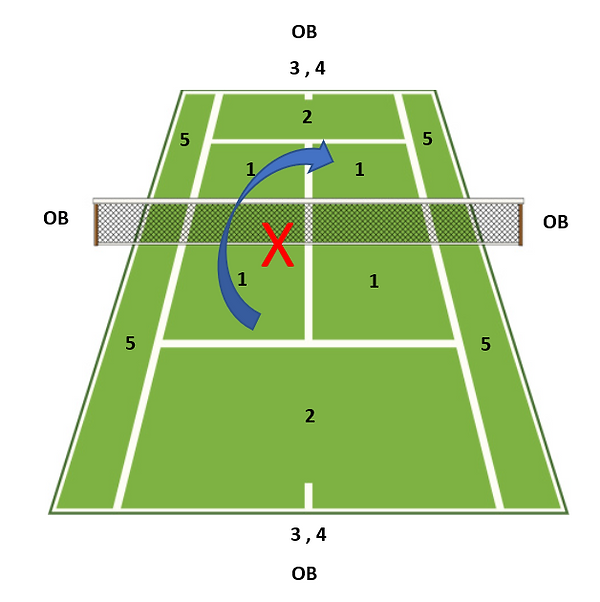
For 5-point kicks, or "fivers," the following diagrams make clear the position of the kicker and the position of the defender.

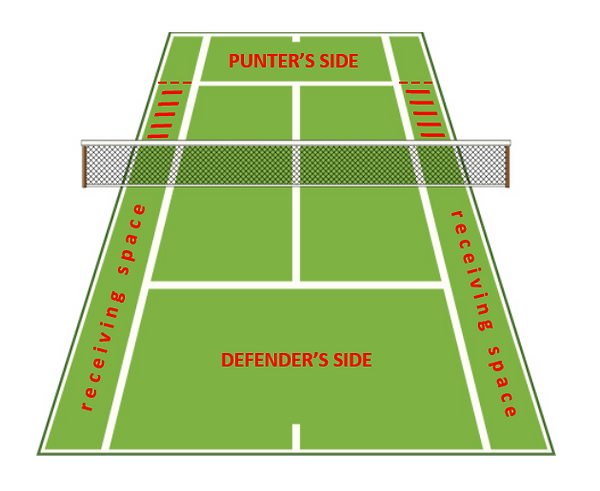

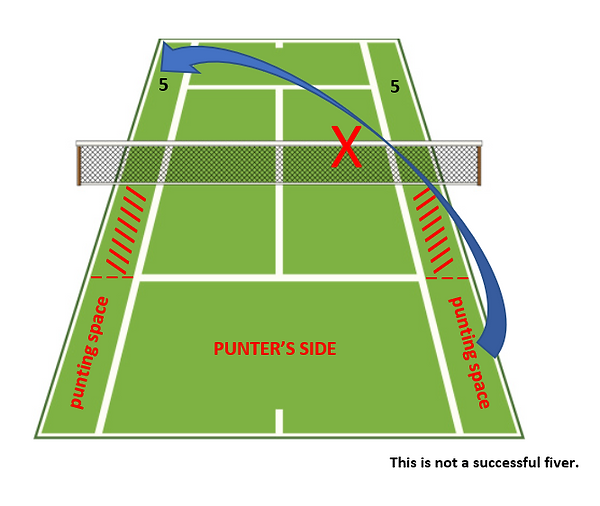
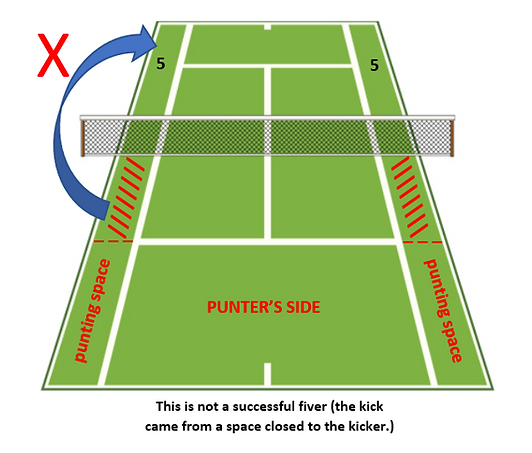
4e. A kicker can do a 3-pointer kick by standing behind the back OB (out of bounds) line in the "back room" o the court (see below) and by having the kick bounce once on the defender's side and then land in the defender's OB space on the second bounce. Before the kick is made, the kicker must signal that they are kicking a 3-pointer by raising their hand above their head and pointing their index finger up. Once this signal is made, the kicker cannot change the kick. If the signal is not made and the kicker attempts the kick, the kick is void and the defender gets the ball.
4e.1. If a kick lands directly on the OB line, it is considered to have landed in-bounds.
4e.2. If a defender catches a 3-point attempt in the air before it bounces once, and if the defender is in bounds, the defender gets 1 point and the kicker receives no points. If the defender is out of bounds, they get 2 points and the kicker gets none.
4e.3. If a defender catches a 3-point attempt after it bounces once in bounds but before it bounces a second time, the defender gets 2 points and the kicker receives no points, regardless of where the defender is standing for the catch (in bounds or out of bounds).
4e.4. If a kick lands OB for its first bounce and then bounces in bounds for its second bounce, the kicker must subtract 3 points from their score (the kick is -3). For this reason, no kicker can kick a 3-point kick without first having at least 3 points to lose, since no player can ever have a negative score in Puntball.
4e.5. If a kick lands out of bounds for its first bounce and then bounces in bounds for its second bounce, and if the defender catches the ball in bounds, the defender gets 2 points and the kicker must subtract 3 points from their score.
4e.6. If the defender attempts to catch the ball but fails, and in that attempt makes contact with the ball in any way, the kicker receives the points. Furthermore, if the defender does not attempt to catch the ball but nevertheless the ball hits the defender's body in the air or as it bounces, the kicker receives the points, even in situations that it is unlikely that the ball would have landed out of bounds after its first bounce.
4e.7. If the kick is headed out of bounds from the start, the defender can catch the kick out of bounds before the ball bounces for the first time. In the catch is successful, the defender gains 2 points and the kicker none. However, if the ball lands out of bounds and then bounces once, and the defender then catches the ball out of bounds after the first bounce, the defender receives no points, and the kicker receives no points.
The following diagrams illustrate successful and unsuccessful 3-point kicks.
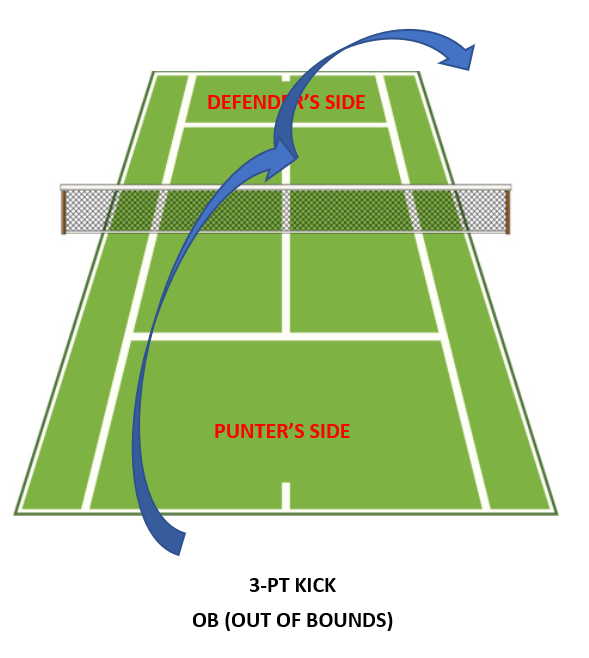
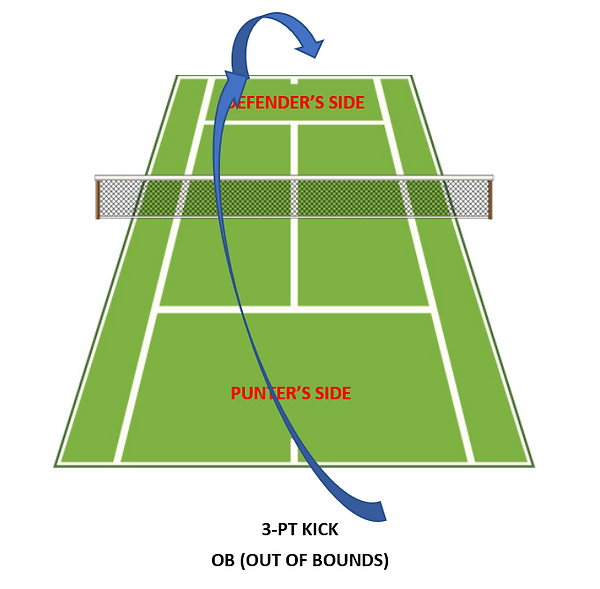

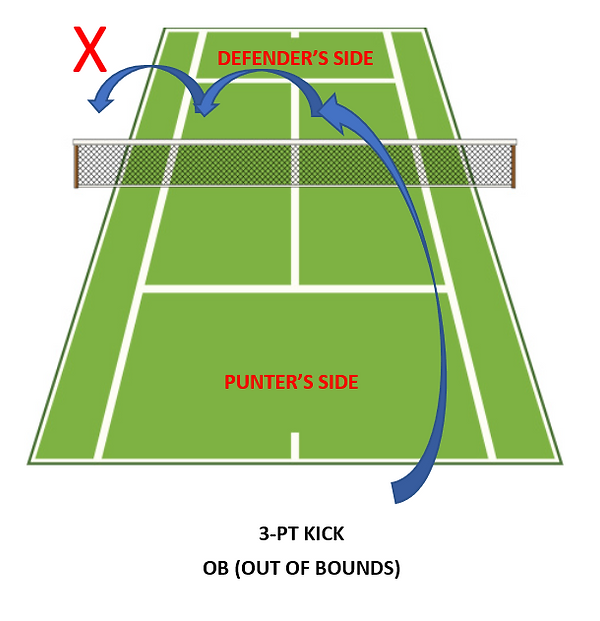
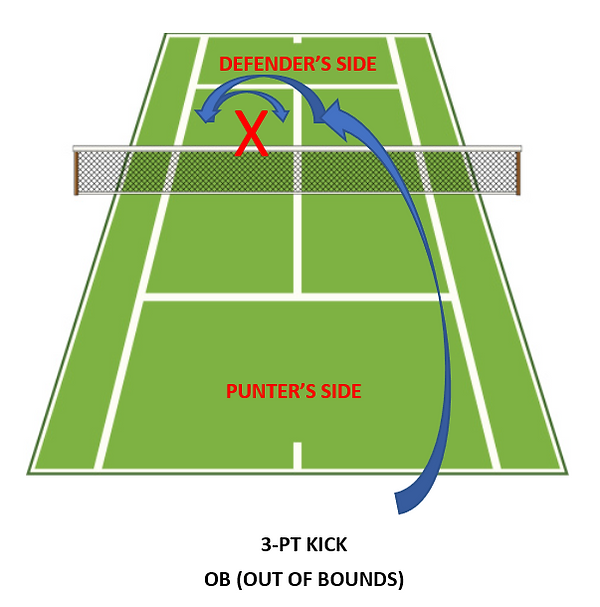

4f. A kicker does a 4-pointer kick by standing directly behind the back OB (out of bounds) line in the "back room" (see below) and by having the kick land on the defender's side of the net and and come to a stand-still on that side without going out of bounds once. Before the kick is made, the kicker must signal that they are kicking a 4-pointer by lowering their hand below their waist and pointing their index finger down. Once this signal is made, the kicker cannot change the kick. If the signal is not made and the kicker attempts the kick, the kick is void and the defender gets the ball.
4f.1. If a kick lands directly on the OB line and bounces back inside, it is considered to have landed in-bounds.
4f.2. If a defender catches a 4-point attempt in the air before it bounces once, and if the defender is in bounds, the defender gets 1 point and the kicker receives no points. If the defender is out of bounds, they get 2 points and the kicker gets none.
4f.3. If a defender catches a 4-point attempt after it bounces once in bounds but before it bounces a second time, the defender gets 3 points and the kicker receives no points, regardless of where the defender is standing for the catch. Note that this is different from the 3-point attempt, where the defender gets 2 points for catching the ball after the first bounce and before any other bounces.
4f.4. If a kick lands OB for its first bounce and then bounces in bounds for its second bounce, the kicker must subtract 3 points from their score (the kick is -3). For this reason, no kicker can kick a 4-point kick without first having at least 3 points to lose, since no player can ever have a negative score in Puntball.
4f.5. If a kick lands OB for its first bounce and then bounces in bounds for its second bounce, and if the defender catches the ball in bounds, the defender gets 3 points and the kicker must subtract 3 points from their score.
4f.6. If the ball comes to rest in bounds in such a way that the nose of the football or any other part of the football hangs over the OB line, such that if a plane were to extend upward from any part of the line, then the ball would be touching the plane, then the kicker receives the points for the kick, even if the majority of the ball may be resting out of bounds.
4f.7. If the defender attempts to catch the ball but fails, and in that attempt makes contact with the ball in any way, the kicker receives the points. Furthermore, if the defender does not attempt to catch the ball but nevertheless the ball hits the defender's body in the air or as it bounces, the kicker receives the points, even in situations that it is unlikely that the ball would have landed out of bounds after its first bounce.
4f.8. If the kick is headed out of bounds from the start, the defender can catch the kick out of bounds before the ball bounces for the first time. In the catch is successful, the defender gains 2 points and the kicker none. However, if the ball lands out of bounds and then bounces once, and the defender then catches the ball out of bounds after the first bounce, the defender receives no points, and the kicker receives no points.
The following diagrams illustrate successful and unsuccessful 4-point kicks.
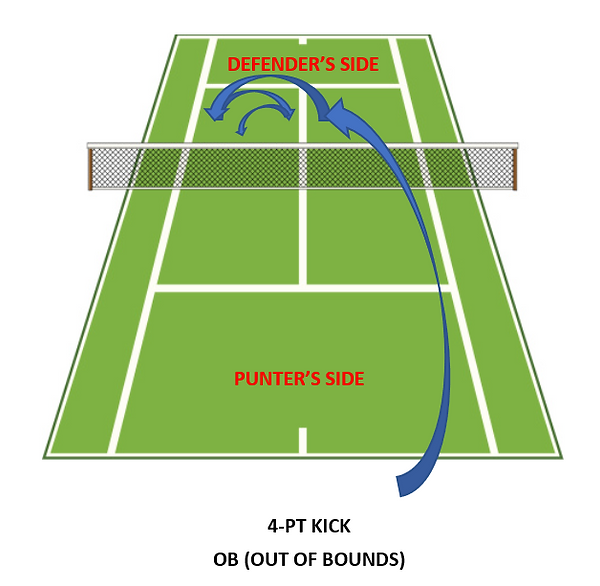



4g. There are two kicks that can automatically win the game for the kicker if successfully done. Each of these kicks is called a "gamer" because with the kick, the game is on the line.
The first type of gamer is kicked from the second half of the five-point channel. A kicker stands in the second half of the 5-point channel and kicks the ball diagonally to the defender's 5-point channel that is the channel not directly in front of the kicker. The kicker must signal before attempting the kick by saying the word "gamer" such that the defender can hear the word. An alternate signal is to lift one hand up shoulder high in a highly-visible, thumbs-up formation. This signal must be given before the kick makes contact with the ball. If the signal is late, the kick is void and the ball transfers to the other player. Once the signal is given, the kicker cannot change the kick and now must kick a gamer.
4g.1. If a kick lands in the defender's adjacent 5-point channel (that is, the channel not directly in front of the kicker), then the kicker automatically wins the game.
4g.2. If the defender catches the kick, the defender automatically wins the game, regardless of where the defender's feet end up after the kick.
4g.3. If a defender attempts to catch the gamer, makes contact with the ball, and misses the catch, the kicker wins the game regardless of whether the kick is contested or not (in this case, this is an exception of the batting rules).
4g.4. If the defender attempts to catch the ball but fails to do so and also fails to make any contact whatsoever with the ball in the attempt, the defender is not penalized in any way if the kick misses. The kicker now has the ball, and play continues.
4g.5. If the kicker misses the gamer, and the defender misses it as well but does not touch it, the kicker must subtract one point from their score. Because of this, a kicker must have at least 1 point before attempting a gamer since one can never have a negative score in Puntball.
4g.6. If the kicker misses the gamer because the ball hits the net and falls back into the kicker's side of the court (a "net ball"), the kicker must subtract one point from their score. The kicker can then re-kick, choosing any kick they want.
4g.7. If for whatever reason the defender wishes to waive the right to win the game upon catching an in-coming gamer, they must call out "waive" or simply wave one of their hands above their head in an obvious way as the kick is in the air. If the defender then catches the ball, the kicker does not win but neither does the defender. However, kicker must subtract 1 point from their score. By using this waive rule, the defender has elected to continue play instead of an outright win. This may be because the defender is attempting to get a stick-skunk series or a super stick-skunk series.
The following diagram illustrates a successful kick for this first type of gamer. Because this kick is attempting to land in a diamond-shaped swath of the defender's five-point channel, it is called the "diamond gamer".
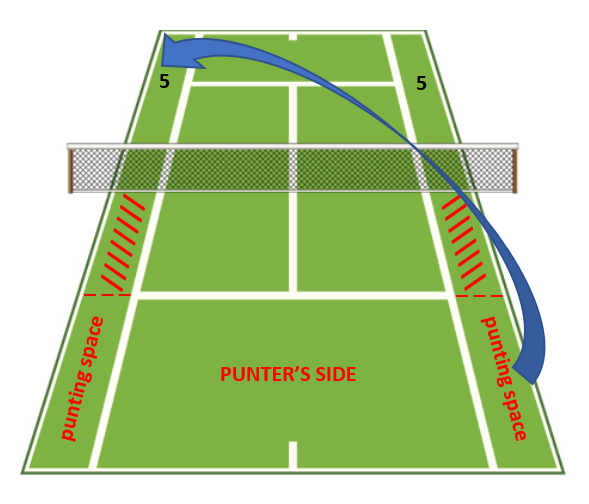
4h. The second type of gamer is kicked from behind the back line of the court. That is, the kicker must be positioned in the space for the 3-pt kick and the 4-pt kick. For this gamer, one must envision a box extending from the back court line back 7 yards, or paces. The sides of the box are the outer side lines of the court running back 7 yards. This is called the "backroom". NOTE: If there is a fence surrounding the court, the fence is out of bounds. So a backroom gamer that hits the fence first before landing on the court is a failed gamer.
As with the first type of gamer, the kicker must signal before attempting the second gamer by saying the word "gamer" such that the defender can hear the word. An alternate signal is to lift one hand up shoulder high in a highly-visible, thumbs-up formation. This signal must be given before the kick makes contact with the ball. If the signal is late, the kick is void and the ball transfers to the other player. Once the signal is given, the kicker cannot change the kick and now must kick a gamer.
4h.1. If a kick lands in the defender's "backroom" (that is, the imaginary box extending back 7 paces from the back court line and not extending past the court's outermost side lines were they to extend backwards 7 paces), then the kicker automatically wins the game.
4h.2. If the defender catches the kick, the defender automatically wins the game, regardless of where the defender's feet end up after the kick.
4h.3. If a defender attempts to catch the gamer, makes contact with the ball, and misses the catch, the kicker wins the game regardless of whether the kick is contested or not (in this case, this is an exception of the batting rules).
4h.4. If the defender attempts to catch the ball but fails to do so and also fails to make any contact whatsoever with the ball in the attempt, the defender is not penalized in any way if the kick misses. The kicker now has the ball, and play continues.
4h.5. If the kicker misses the gamer, and the defender misses it as well but does not touch it, the kicker must subtract 2 points from their score. Because of this, a kicker must have at least 2 points before attempting a gamer since one can never have a negative score in Puntball.
4h.6. If the kicker misses the gamer because the ball hits the net and falls back into the kicker's side of the court (a "net ball"), the kicker must subtract 2 points from their score. The kicker can then re-kick, choosing any kick they want.
4h.7. If for whatever reason the defender wishes to waive the right to win the game upon catching an in-coming gamer, they must call out "waive" or simply wave one of their hands above their head in an obvious way as the kick is in the air. If the defender then catches the ball, the kicker does not win but neither does the defender. The kicker then must subtract 2 points from their score. By using this waive rule, the defender has elected to continue play instead of an outright win. This may be because the defender is attempting to get a stick-skunk series or a super stick-skunk series.
The following diagram illustrates a successful kick for this second type of gamer. Because it is attempting to land in the defender's backroom, it is called the "backroom gamer".

RULE NO. 5: Catching
On one level, everyone knows how to catch a ball. But things get a complicated in puntball! Let's start with what makes a catch.
A defender catches the ball by securing it in their hands or against their body with their hands or other body parts including and above the knees (arm, wrist, thighs, etc.) and also by then establishing control of their body directly after the catch. This is called "catch and control." Typically, if a defender has control after the catch, this means they can control their stride by continuing in the direction they are running in or turning in a new direction in a balanced way and by being able to intentionally adjust their speed or come to a standstill. In contrast, a defender who catches the ball and then steps into a declared box because they cannot help it (they don't yet have control of their balance, stride, or speed), has not yet established control and consequently has not yet made a complete catch.
If the defender, in an attempt to catch the ball, touches the ball at the same time the ball touches the court, there is no catch.
Further rules governing catching:
5a. A kicker declares which box they are aiming at by having their plant leg in the box on their side while making the kick, or by signaling for a 3- or 4-pointer, or by calling out "gamer" for a gamer kick. The box the ball is aimed at by the kicker is therefore called the "declared box." A defender who catches an incoming kick but while holding the ball has two feet down at the same time on the court for any moment of time, and if at least one foot is in the declared box the kicker was aiming at, earns 1 point for the catch, but the kicker still receives the allotted number of points for the kick.
5b. A defender that catches an incoming kick on one leg and hops out of the declared box so that the defender's two feet are never simultaneously in contact with the declared box or the court in general during the act of catch and control for these first two steps receives points for the catch but in this manner keeps the kicker from scoring any points. This catch is called a "flamingo." If a defender flamingos out of the box the kick was intended for but lands elsewhere on the court in bounds, the defender receives 1 point and the kicker receives no points. If the defender flamingos directly from the declared box out of bounds (the second foot lands out of bounds while the first foot is in the air, no matter how minutely), the defender receives 2 points and the kicker none. Flamingos can happen while standing still with one foot off the ground or in stride as one runs, as long as once the defender touches the ball only one foot lands in the box and then is lifted as the other foot lands outside the box. At no point can both feet be touching the ground at once while the catch is being made.
A defender can prepare for a flamingo by simply standing still and lifting one foot while watching the kick come in, catching the kick, and then hopping out of the declared box. This is a standing flamingo, and the leg that was touching the court as the ball was caught is the "plant leg" of the flamingo. On the other hand, a moving flaming is made on the run. There are two types of moving flamingos. The first type has the runner touching the ball while at the same time having one foot touching the ground. This foot is automatically the plant foot for the flamingo and must be lifted off the ground before the next step the runner takes hits the court. The second type of the moving flamingo has the player jumping up to catch the ball with both feet off the court. As the catch is made, the player then lands with one foot on the court first. This is the flamingo's plant foot. This plant foot must now be lifted off the ground as the next step the defender makes lands. At no point for either the standing or moving flaming can the plant foot pivot or swivel on the ground. The plant foot must make clean, non-shifting contact with the ground and then must be lifted off the ground before the other foot lands.
5c. A defender can intentionally or unintentionally bobble the ball only once and then must secure the catch. If there is more than one bobble, the kick counts, even if the defender eventually secures the catch. (See "Batting" below.) A bobble occurs when the ball hits the defender and bounces back into the air, regardless of how small the bounce is. A ball that stays in motion but also in continuous contact with the defender's body is not considered a bobble. Any body part above the knees and including the knees can be used to bobble the ball. Under no circumstances can a defender use their feet or shins (below the knee) to bobble the ball.
5d. If a defender catches a kick outside the box the kick was intended for but while in the act of securing the catch steps into the intended box or steps on the line of the intended box (remember, the line is always in), the defender receives 1 point for making the catch but the kicker also receives the allotted number of points.
5e. If a defender catches a kick outside of the box the kick was intended for and then runs into that same box to make a kick, they must demonstrate control of stride, speed, and balance by either slowing down and then speeding up again or changing directions and then reversing the change (zigzagging). This is to demonstrate that they are not falling into the declared box (see 5d above). This is not required if the catch is made at such a distance from the declared box that the catcher is easily seen to have established control as they run in a direct line to their intended location on the court.
5f. A defender who catches a "dead" kick (an illegal kick; for example, a 3-pt kick that was kicked without the signal, or a kick with the kicker's plant foot on a line, or a gamer that was kicked before the word "gamer" was called), they do not earn any points for the catch as the play is dead as soon as the illegal kick was made. There is simply a transfer of possession.
5g. A player may reach over the net to catch a ball as long as the player never touches the net and as long as the ball is in the air. If the player touches the net, they break the "Touch Net" rule and the proper penalty must be assessed.
5h. A defender can never reach over and touch the ball when it is in a kicker's hands. This can occur if the defender is extending over the net to block and accidentally touches the ball or if the offense sees the opportunity and extends to get the ball over the net to touch the defensive player in any way. If this situation occurs, then the kicker (offense) has the option to either subtract one point from the opponent's score or to add one point to their (the offense's) score. Play then resumes with the offense still in possession of the ball.
RULE NO. 6: Batting
If you want to go after an incoming kick, either catch it or leave it alone! There's no in-between.
6a. When a kick is swatted away by a defender, it is called "batting." As batting is illegal in puntball, most types of batting carry a penalty of granting the kick. The one type of batting that doesn't result in a penalty is swatting away a ball that has absolutely no chance of landing in the intended box if left alone. That is, if the kick is so far off course or is so short (or long) of its goal that batting it down without catching it cannot affect the outcome of an untouched flight, then doing so is not something that will be penalized. The inaccuracy of this type of kick should be obvious to all players on the court.
6b. However, if an incoming kick actually looks like it might land in the box it is intended for, then a defender can try to catch the ball or can leave it alone. If the defender tries to catch it and fails, and the ball ends up being moved off-course by the defender's actions, the ball has been batted and the kicker receives the points that would have resulted from a successful kick. This is called a "contested ball" and the outcome of a contested ball's flight always benefits the kicker.
6c. A defender can intentionally bat a ball away from its intended box if the defender ends up successfully catching it after one bat (or "bobble" which can be defined as one act of juggling the ball as the defender tries to catch it). Any part of the body above the knee, including the knees, can be used to do the bobble. No part of the leg below the knees can touch the ball outside of the punting action that occurs on offense.
6d. If a defender in bounds intentionally bats an in-bound ball in order to send it out of bounds, and then catches that ball out of bounds after that one bat (which counts as a bobble), the defender gets 2 points and the kicker none, as long as the defender was also out of bounds when the catch was made.
6e. It a kick is not on course to land in its intended box, and if any foot of the defender is in that intended box touching the court at the same time the defender extends outward and touches the wayward ball in a failed attempt to catch the ball, the kicker receives the points of the intended kick. In essence, the defender is "one with the box" when any part of their body is touching the kicker's intended box, so the ball itself touches the box when it touches a defender in the box. Therefore, if the defender fails to catch the ball and flamingo out of the box, or if the defender is in a box and then reaches over to try to catch a wayward kick and makes contact with the ball while still having any part of their foot in the box or line, the kicker receives the points since in touching the defender the ball technically touches the box it was aiming for.
This is not the case if the defender is outside the kicker's intended box. This is to say, a defender who is not inside, or touching the line, of the box the kicker is aiming at is not "one with the box" and thus if a non-contested ball (a miskicked ball that has no chance to land in the intended box) touches the defender in any way, it is not considered to have touched the court yet, since the defender is not part of any box at this point. However, this leads to a possible scenario which gives the kicker points: if a miskicked ball first hits the defender and then in the ricochet lands in the kicker's intended box, the kicker receives the points for the kick, since in touching the court for the first time the ball actually lands in the intended box. In essence, a defender who tries to catch a kick and fails (or simply has the ball make contact with the body and then bounce away) may unintentionally correct the ball's flightpath and send it back into the intended box, thus giving the kicker a technically accurate kick.
RULE NO. 7: Scoring
The following are the rules of scoring, but the foundation of scoring, of earning series points, and of all of puntball, really, is . . . HONESTY! Be completely honest when you play puntball. Treat your opponent the same way you want them to treat you. And if there is any doubt as to where a ball lands, defer to the opinion of the player closest to the ball.
7a. Series play is based on 7 games, and whoever wins 4 of the 7 games wins the series. When you win the series, you receive at two series points. You may win more depending on how many skunk games you put together (see below) but you'll always win at least two.
7b. To win a game, you must be the first to reach exactly 10 points. If both you and your opponent reach 10 points at the same time, both scores drop back to zero (the game resets). If you go over 10 points, your score resets to 5.
7c. If you have 6 points or more while your opponent has 0, you've won the game and the game is labelled as a skunk. Other skunks are 7-0, 8-0, 8-1, 9-0, 9-1, 10-0, 10-1, and 10-2.
7d. If you win the series with four skunks, you receive 4 series points. This is called a "stick skunk," which refers to the original way small wooden sticks laid on the tennis court were used as tallies to keep track of game wins/loses in a series. If you win four games (all non-skunk wins or a mix) and your opponent has won zero games, then this also is a stick skunk, and you receive 4 series points. If you win the series four games to zero, and every one of your games is a skunk, then you've put together a "super stick skunk," and this is worth 16 series points. Super stick skunks are really rare!
7e. A series can be suspended only if both players agree to suspend play and to resume the series at a later date. A player who refuses to suspend the series can force the play to continue, and the play must continue. The other player cannot refuse. A series can be stopped if both players agree to stop the series. A stopped series differs from a suspended series in that a suspended series will be finished in the future whereas a stopped series simply ceases to exists. It is as if the games in the stopped series never were played. If a player refuses to stop, however, the series must continue. Players cannot forfeit a game.
7f. If you are playing an opponent who has no series points, you cannot count toward your own registered totals any series points you earn by winning the series. That is, a person must have at least two series points for you to be able to count your own wins against them for series points.
7g. Keep track of your series points. We update the registered totals (series points for players listed on our web site) at the end of June and of December. Send us the number you want us to add to your old totals. Use the email address worldofpuntball@gmail.com and put the words "Series Points for <your full name>" in the subject line. In the email, please include the contact info (phone number) of a playing partner we can call to confirm your participation.
RULES FOR TEAM PLAY
THE RULES FOR TEAM PLAY ARE THE SAME THE RULES FOR SINGLE PLAYER SERIES PLAY, EXCEPT FOR THE FOLLOWING ADDITIONS AND MODIFICATIONS.
RULE NO. 8: Size and Identity
No team can be larger then 5 members. All teams must have a team name, a logo, and a designated captain. All teams must register this information on our website as well as a list of the team members.
RULE NO. 9: Court Presence
Only two players can be competing on the court at the same time. Substitutions are made by one player simply stepping out of the court and a new player stepping in. A player who exits play must remain out of play for at least two new and full offensive possession for their team.
RULE NO. 10: Opponents
A team usually plays against other teams but can play against a single player if the player agrees to do so. The single player does not accrue extra series points by competing against a team. However, this is not the case for tournament play. Teams can play as teams only in team-tournament play.
RULE NO. 11: The Pass
A team can pass the ball among themselves only twice per offensive possession. The pass occurs when one player on a team transfers the ball through the air to another play on the same team. This can take place on any part of the court and out-of-bounds at any time the offense has the ball. While a kick can be made at any time during a possession by any team member on the court, the player who receives the second pass (if there is a second pass) must be the player who kicks the ball. If a pass is dropped, that is a net ball and the team has only one pass left, or no passes if that was the second pass . There is no hand-off in Puntball. A ball can be transferred from one player to another during a live possession only by passing.
11a. A player who is holding the ball and accidentally drops it while not intending to pass it does not incur a net ball if the the foot was not rising off the ground to attempt a kick.
11b. If after a second successful catch there is a first netball (that is, the team attempted two passes and both were caught, and then tried their first kick and that first kick hits the net, the first person to pick up the ball is the person who must kick the second kick.
11c. When a team does two net balls in one possession (whether the net balls are in succession, as they usually are when kicked, or not) they surrender the ball to the other team and the other team also receives a point. The team turning over the ball does not substract a point from their own score.
RULE NO. 12: Team Series Points
Series points earned during team play accrue both for the team itself and for the individual players. Total points earned are listed under the team's name on our website. Individual team players can decide for themselves how to divide the points when it comes to individual listings on our site. However, no team member that has not played at least one full game in the series can receive points.
The total of the individual listings must equal the total listed under the team. For example, Team A earns 4 series points one afternoon. Of the four members of the team, only players 1 and 2 played that day. Because of player 1's stellar play, the two may decide to award player 1 three of the points and player 2 one of the points. On our site, the team's point listing increased by 4, player 1's points increase by 3, and player 2's by 1.
RULES FOR TOURNAMENT PLAY
THE RULES FOR TOURNAMENT ("TOURNEY") PLAY ARE THE SAME THE RULES FOR SINGLE PLAYER SERIES PLAY OR FOR TEAM SERIES PLAY, EXCEPT FOR THE FOLLOWING ADDITIONS AND MODIFICATIONS.
RULE NO. 13: Tournament Identity
All official tournaments must be registered on the World of Puntball website. These further conditions must also be met.
13a. Tournaments can be single-player or team tournaments. They simply need to be clearly advertised and labeled as such before play commences. A single player can enter a team tourney if they wish, but a team cannot enter a singles' tourney
13b. If the points gained through the tourney are to be official series points , the tournament must be listed on our website, including the final results of the tournament (name of tournament, date and place, and top three scores).
13c. Tournaments can be "open" or "invitational." An open tournament is one whose field is formed by whoever chooses to apply. If the application is in order, the individual (or team) cannot be refused entry. The field is populated in a first-come-first-served manner. An invitational is a tournament whose participants are selected and officially asked to participate by the tournament formers. In this way, an invitational reserves the right to be exclusive either on merit (the tournament formers choose the best players (teams) to compete) or on other grounds agreed upon by the tournament founders.
RULE NO. 14: Tournament Size
Tournaments must have a minimum of 3 entries and a maximum of 10.
The rules for tourney play are the same as for series play, except for one very important difference. All puntball tournaments, whether individual-play or team-play, must be scored as "rounds" instead of as series. This means that every player (in individual-play tournaments) or every team (in team tournaments) must play every other player or team at least once (for single-round tournament), twice, for double-round tournaments, or three times for triple-rounders.
14a. A player (or team) playing rounds plays only one 10-point game with another player (or team) and then moves on to a new opponent, never playing the same opponent in the same round.
14b. Tournament play can be simultaneously conducted across multiple courts.
14c. Each player (or team) must report each game's outcome as soon as the game is over to the official record keeper of the tourney. If this is not done, the player (or team) is disqualified.
14d. No tournament can be longer than three rounds.
14e. A single tournament can be synchronous (happening in real time, all at once) or asynchronous (spread out over time and/or locale).
RULE 15: Tournament Play Format
15a. Tournaments are played in rounds. A round is closed when every player in the tournament has played one game (just one game, not a best-of-seven series) with every other player in the tournament.
15a.1. Since every player must play every other player, there is no need to seed the players.
15a.2.
15b. Tournaments can be single-round, double-round, or triple-round. No tournament recognized by the puntball commissioner and the official puntball website (worlofpuntall.com) can have more than three rounds.
15c. Every tournament must have a tournament director. The director must do the following:
15c.1. Register the tournament with the current commissioner. An email sent to the commissioner with the tournament details is enough to register the tournament.
15c.2. Manage enrollment. This means accepting applications for open tournaments or issuing invitations for invitational tournaments.
15c.3. Assign courts to the players during the tourney play.
15c.4. Handle in-play issues that may arise.
15c.5. Record wins, losses, and differentials after every round.
15c.6. Report tournament results to the commissioner for posting on the web site.
15d. The win/loss/differential record of every game must be recorded. The differential is the amount the winner wins the game by (that is, the winning score minus the other player's score). At the end of the tournament, the player with the best win record wins first place, the player with the second best, second place, and the player with the third best, third. In case of players who end up tied with the simple win record, the player with the highest differential wins the tie. Should a tie be exact (same number of wins, and same differential total), then the two players play a best-of-seven series match. The winner of the match wins the tie.
RULE 16: Tournament Point Allotment
Tournaments have unique point allotments that must be followed in all cases.
16a. The top number of points a tourney has is always equal to the number of players times the number of rounds a tourney has. For example, a tournament with three player and two rounds has a top of 6 points. A tourney of 10 players with only 1 round has a top of 10 points.
16b. The winner of the tournament earns the full number of points. The second-place player gets half of the top number of points. The third gets a third of the top number of points. No other player receives points.
16c. All point divisions for send and third place get rounded down. For example, the winner of a 5-person tournament with three rounds gets 15 points. The second-place player receives 7 points (7.5 rounded down), and the third-place player receives 5 points.
RULES FOR SOLO PLAY
SOLO PLAY (OR "PUNTBALL SOLO") IS ONE PLAYER PLAYING ALONE ON THE COURT. SERIES POINTS CAN BE EARNED IN SOLO PLAY AS A REWARD FOR DILIGENT AND STRUCTURED PRACTICE.
THERE ARE TWO TYPES OF SOLO GAMES: FULL-COURT SOLO (2 pts possible) AND BACKROOM SOLO (1 pt possible).
RULE NO. 17: Ball Count for Both
A player can use one or two balls simultaneously while playing puntball solo, but not more than two. This is for the sake of the other people playing in adjacent courts.
RULE NO. 18: Kick Progression for Full-Court Solo
Full-court solo is designed to have a player practice all the kicks in the game, on each side of the court.
18a. The game begins with the kicker successfully landing a "greenlight." A greenlight is a fiver. Once the player receives the greenlight, the actual solo game can begin. A player can quit a game at any time but cannot start a new game without first landing a greenlight fiver.
18b. Once the player lands the greenlight, the player then moves on to the 1-point box immediately adjacent to the 5-point channel used for the greenlight. The kicker must make the 1-point kick from that box and then must move on to the next 1-point box. From there, the kicker has to make a 2-point kick, a 3-point kick, a 4-point kick, a fiver (from the channel opposite the channel used for the greenlight kick), and a diamond gamer from any channel.
18c. If the player makes all these kicks after the greenlight without missing one kick, the player earns 2 series points. If the player makes all the kicks and misses only once, they earn 1 series points. The game is over at the moment the player misses a second kick, and the player earns no points.
18d. Three kicks in a row can never occur on the same side of a court. The player must alternate sides after two successive kicks on that side, including missed kicks or net balls.
18e. Net balls count as missed kicks.
18f. If a player forgets where they are in the progression, they can return to an earlier successful kick and proceed again from their, only if they have so far missed no kicks or only one kick.
18g. If a player scores points on their first solo game, the points are doubled. This is called a "walk-on" game, and the greenlight of the walk-on game must be the kicker's first kick of the day. Only full-court solo can have this walk-on situation, and its greenlight must the the first kick of the day for the puntball player.
RULE NO. 19: Kick Progression for Backroom Solo
Backroom solo is designed to have a player practice the backroom gamer. It is also designed to keep the kicks straight up and down the court in case other players are on directly adjacent courts.
19a. The maximum point value for backroom solo is 1 point.
19b. All kicks except the 4-pt kick must be completed on their first attempt.
19c. The game's greenlight kick (see above) is the 2-pt kick. Once this is made, the kicker moves on to the 3-pt kick, the 4-pt kick, and the backroom gamer. If a player makes all of this kicks, they receive 1 point that can be archived under their name on our website.
19d. If the kicker misses the 4-pt kick, they can kick a "mercy shot" by standing in the backroom by the 5-pt channel of their choice, stepping into the channel and then immediately kicking a 5-pt kick. If the kick is made, the kicker can now redo the missed 4-pt kick once. If the 4-pt kick is unsuccessful a second time, the game is over.
19e. There is no walk-on version of short solo.
RULE NO. 20: Sight Recognition in Solo Play
When playing solo, it is important to watch as carefully as possible in order to determine whether kicks land on the line and thus can be considered successful. Sometimes it is clear that the kick is successful, but sometimes, because of the net, the kicker gets a obscured look at the landing. If the angle of sight allows the kicker to truly believe the kick is good, then the kicker can count the kick. However, if because of the instincts and feel a puntball kicker develops as they grow in the game, a kicker may sense that in fact the kick has missed. At that point, the kicker must consider the kick as a failed attempt. Honesty in everything.
